How Much Are Planting Dates for Maize Affected by the Climate Trend? Lessons for Scenario Analysis Using Land Surface Models
Abstract
1. Introduction
2. Materials and Methods
2.1. Study Area and Planting Date Data
2.2. Climate Data
2.3. Analyses
3. Results
3.1. Climate Trends in the Major Maize Production Zones from 1992 to 2010
3.1.1. Spring Maize
3.1.2. Summer Maize
3.2. Trend of Planting Dates
3.2.1. Spring Maize
3.2.2. Summer Maize
3.3. Principal Component Analysis (PCA)
3.3.1. Spring Maize
3.3.2. Summer Maize
3.4. OLS Multivariate Regression Model
3.4.1. Spring Maize
3.4.2. Summer Maize
4. Discussion
5. Conclusions
Supplementary Materials
Author Contributions
Funding
Acknowledgments
Conflicts of Interest
Abbreviations
| Tmin | monthly average minimum temperature |
| T | monthly mean temperature |
| P | monthly precipitation |
| PCA | principal component analysis |
| CLM | Community Land Model |
| CMA | Chinese Meteorological Administration |
| PD | Planting date |
| OLS | ordinary least squares |
| GLS | generalized least squares |
References
- Dickinson, R.E.; Oleson, K.W.; Bonan, G.; Hoffman, F.; Thornton, P.; Vertenstein, M.; Yang, Z.-L.; Zeng, X. The Community Land Model and Its Climate Statistics as a Component of the Community Climate System Model. J. Clim. 2006, 19, 2302–2324. [Google Scholar] [CrossRef]
- Lawrence, D.M.; Oleson, K.W.; Flanner, M.G.; E Thornton, P.; Swenson, S.C.; Lawrence, P.J.; Zeng, X.; Yang, Z.-L.; Levis, S.; Sakaguchi, K.; et al. Parameterization improvements and functional and structural advances in Version 4 of the Community Land Model. J. Adv. Model. Earth Syst. 2011, 3, M03001. [Google Scholar]
- Sacks, W.J.; Cook, B.I.; Buenning, N.; Levis, S.; Helkowski, J.H. Effects of global irrigation on the near-surface climate. Clim. Dyn. 2009, 33, 159–175. [Google Scholar] [CrossRef]
- Levis, S. Modeling vegetation and land use in models of the Earth System. Wiley Interdiscip. Rev. Clim. Chang. 2010, 1, 840–856. [Google Scholar] [CrossRef]
- Mao, J.; Shi, X.; Thornton, P.E.; Hoffman, F.M.; Zhu, Z.; Myneni, R.B. Global Latitudinal-Asymmetric Vegetation Growth Trends and Their Driving Mechanisms: 1982–2009. Remote Sens. 2013, 5, 1484–1497. [Google Scholar] [CrossRef]
- Ramankutty, N.; Evan, A.T.; Monfreda, C.; Foley, J.A. Farming the planet: Geographic distribution of global agricultural lands in the year 2000. Glob. Biogeochem. Cycles 2008, 22, GB1003. [Google Scholar] [CrossRef]
- Ma, S.; Churkina, G.; Trusilova, K. Investigating the impact of climate change on crop phenological events in Europe with a phenology model. Int. J. Biometeorol. 2011, 56, 749–763. [Google Scholar] [CrossRef] [PubMed]
- Peng, B.; Guan, K.; Chen, M.; Lawrence, D.M.; Pokhrel, Y.; Suyker, A.; Arkebauer, T.; Lu, Y. Improving maize growth processes in the community land model: Implementation and evaluation. Agric. For. Meteorol. 2018, 250–251, 64–89. [Google Scholar] [CrossRef]
- Kucharik, C.J. Contribution of Planting Date Trends to Increased Maize Yields in the Central United States. Agron. J. 2008, 100, 328–336. [Google Scholar] [CrossRef]
- Twine, T.E.; Kucharik, C.J.; Foley, J.A. Effects of Land Cover Change on the Energy and Water Balance of the Mississippi River Basin. J. Hydrometeorol. 2004, 5, 640–655. [Google Scholar] [CrossRef]
- Deryng, D.; Sacks, W.J.; Barford, C.C.; Ramankutty, N. Simulating the effects of climate and agricultural management practices on global crop yield. Glob. Biogeochem. Cycles 2011, 25, 96–101. [Google Scholar] [CrossRef]
- Sacks, W.J.; Deryng, D.; Foley, J.A.; Ramankutty, N. Crop planting dates: An analysis of global patterns. Glob. Ecol. Biogeogr. 2010, 19, 607–620. [Google Scholar] [CrossRef]
- Waha, K.; van Bussel, L.G.J.; Müller, C.; Bondeau, A. Climate-driven simulation of global crop sowing dates. Glob. Ecol. Biogeogr. 2012, 21, 247–259. [Google Scholar] [CrossRef]
- Dobor, L.; Barcza, Z.; Hlásny, T.; Árendás, T.; Spitkó, T.; Fodor, N. Crop planting date matters: Estimation methods and effect on future yields. Agric. For. Meteorol. 2016, 223, 103–115. [Google Scholar] [CrossRef]
- Jahan, M.; Sen, R.; Ishtiaque, S.; Choudhury, A.K.; Akhter, S.; Ahmed, F.; Biswas, J.C.; Manirruzaman, M.; Miah, M.M.; Rahman, M.; et al. Optimizing sowing window for wheat cultivation in Bangladesh using CERES-wheat crop simulation model. Agric. Ecosyst. Environ. 2018, 258, 23–29. [Google Scholar] [CrossRef]
- Mathison, C.; Deva, C.; Falloon, P.; Challinor, A.J. Estimating sowing and harvest dates based on the Asian summer monsoon. Earth Syst. Dyn. 2018, 9, 563–592. [Google Scholar] [CrossRef]
- Drewniak, B.; Song, J.; Prell, J.; Kotamarthi, V.R.; Jacob, R. Modeling agriculture in the Community Land Model. Geosci. Model Dev. 2013, 6, 495–515. [Google Scholar] [CrossRef]
- Oleson, K.W.; Lawrence, D.M.; Bonan, G.B.; Drewniak, B.; Huang, M.; Koven, C.D.; Levis, S.; Li, F.; Riley, W.J.; Subin, Z.M.; et al. Technical Description of Version 4.5 of the Community Land Model (CLM). Ncar Technical Note NCAR/TN-503 + STR; National Center for Atmospheric Research: Boulder, CO, USA, 2013; p. 422. [Google Scholar]
- Sheng, M.; Liu, J.; Zhu, A.-X.; Rossiter, D.G.; Zhu, L.; Peng, G. Evaluation of CLM-Crop for maize growth simulation over Northeast China. Ecol. Model. 2018, 377, 26–34. [Google Scholar] [CrossRef]
- Kucharik, C.J. A Multidecadal Trend of Earlier Corn Planting in the Central USA. Agron. J. 2006, 98, 1544–1550. [Google Scholar] [CrossRef]
- Rosenzweig, C.; Parry, M.L. Potential impact of climate change on world food supply. Nature 1994, 367, 133–138. [Google Scholar] [CrossRef]
- Tubiello, F.N.; Donatelli, M.; Rosenzweig, C.; Stockle, C.O. Effects of climate change and elevated CO2 on cropping systems: Model predictions at two Italian locations. Eur. J. Agron. 2000, 13, 179–189. [Google Scholar] [CrossRef]
- CMA Archives. Chinese Meteorological Administration Archives. 2010. Available online: http://data.cma.cn/ (accessed on 12 June 2019).
- Tao, F.; Zhang, S.; Zhang, Z.; Rötter, R.P. Maize growing duration was prolonged across China in the past three decades under the combined effects of temperature, agronomic management, and cultivar shift. Glob. Chang. Boil. 2014, 20, 3686–3699. [Google Scholar] [CrossRef] [PubMed]
- IARRP. Institute of Agricultural Resources and Regional Planning, CAAS. AgriData, 2016. Available online: http://www.agridata.cn (accessed on 12 June 2019).
- IIASA/FAO. Global Agro-Ecological Zones (GAEZ v3.0); IIASA/FAO: Laxenburg, Austria; Rome, Italy, 2012. [Google Scholar]
- Zhao, J.; Guo, J.; Xu, Y.; Mu, J. Effects of climate change on cultivation patterns of spring maize and its climatic suitability in Northeast China. Agric. Ecosyst. Environ. 2015, 202, 178–187. [Google Scholar] [CrossRef]
- Zhang, X.-J.; Tang, Q.; Pan, M.; Tang, Y. A Long-Term Land Surface Hydrologic Fluxes and States Dataset for China. J. Hydrometeorol. 2014, 15, 2067–2084. [Google Scholar] [CrossRef]
- Van Oort, P.; Timmermans, B.; Van Swaaij, A. Why farmers’ sowing dates hardly change when temperature rises. Eur. J. Agron. 2012, 40, 102–111. [Google Scholar] [CrossRef]
- Sarbu, C.; Pop, H.F. Principal component analysis versus fuzzy principal component analysis A case study: The quality of danube water (1985–1996). Talanta 2005, 65, 1215–1220. [Google Scholar] [CrossRef]
- Shrestha, S.; Kazama, F. Assessment of surface water quality using multivariate statistical techniques: A case study of the Fuji river basin, Japan. Environ. Model. Softw. 2007, 22, 464–475. [Google Scholar] [CrossRef]
- Helena, B.; Pardo, R.; Vega, M.; Barrado, E.; Fernandez, J.M.; Fernandez, L. Temporal evolution of groundwater composition in an alluvial aquifer (Pisuerga River, Spain) by principal component analysis. Water Res. 2000, 34, 807–816. [Google Scholar] [CrossRef]
- Hayton, J.C.; Allen, D.G.; Scarpello, V. Factor Retention Decisions in Exploratory Factor Analysis: A Tutorial on Parallel Analysis. Organ. Res. Methods 2004, 7, 191–205. [Google Scholar] [CrossRef]
- An Introduction to Psychometric Theory with Applications in R. Available online: http://personality-project.org/r/book (accessed on 12 June 2019).
- Fox, J.; Weisberg, S. Robust Regression in R: An Appendix to “An R Companion to Applied Regression”, 2nd ed.; Sage: Thousand Oaks, CA, USA, 2010; Available online: https://socialsciences.mcmaster.ca/jfox/Books/Companion-1E/appendix-robust-regression.pdf (accessed on 12 June 2019).
- Venables, W.N.; Ripley, B.D. Modern Applied Statistics with S. Fourth Edition; Springer: New York, NY, USA, 2002. [Google Scholar]
- Lobell, D.B.; Burke, M.B. On the use of statistical models to predict crop yield responses to climate change. Agric. For. Meteorol. 2010, 150, 1443–1452. [Google Scholar] [CrossRef]
- Parker, P.S.; Shonkwiler, J.S.; Aurbacher, J. Cause and Consequence in Maize Planting Dates in Germany. J. Agron. Crop Sci. 2017, 203, 227–240. [Google Scholar] [CrossRef]
- Tao, F.; Zhang, Z.; Xiao, D.; Zhang, S.; Rötter, R.P.; Shi, W.; Liu, Y.; Wang, M.; Liu, F.; Zhang, H. Responses of wheat growth and yield to climate change in different climate zones of China, 1981–2009. Agric. For. Meteorol. 2014, 189, 91–104. [Google Scholar] [CrossRef]
- Rakib, M.A.; Sasaki, J.; Pal, S.; Asif Newaz, M.; Bodrud-Doza, M.; Bhuiyan, M.A.H. An investigation of coastal vulnerability and internal consistency of local perceptions under climate change risk in the southwest part of Bangladesh. J. Environ. Manag. 2018, 231, 419–428. [Google Scholar] [CrossRef] [PubMed]
- Mu, J.; Zhao, J.; Guo, J. Response of spring maize growth stage to climate change in Northeast China over the past 30 years. J. Appl. Meteorol. Sci. 2014, 25, 680–689. [Google Scholar]
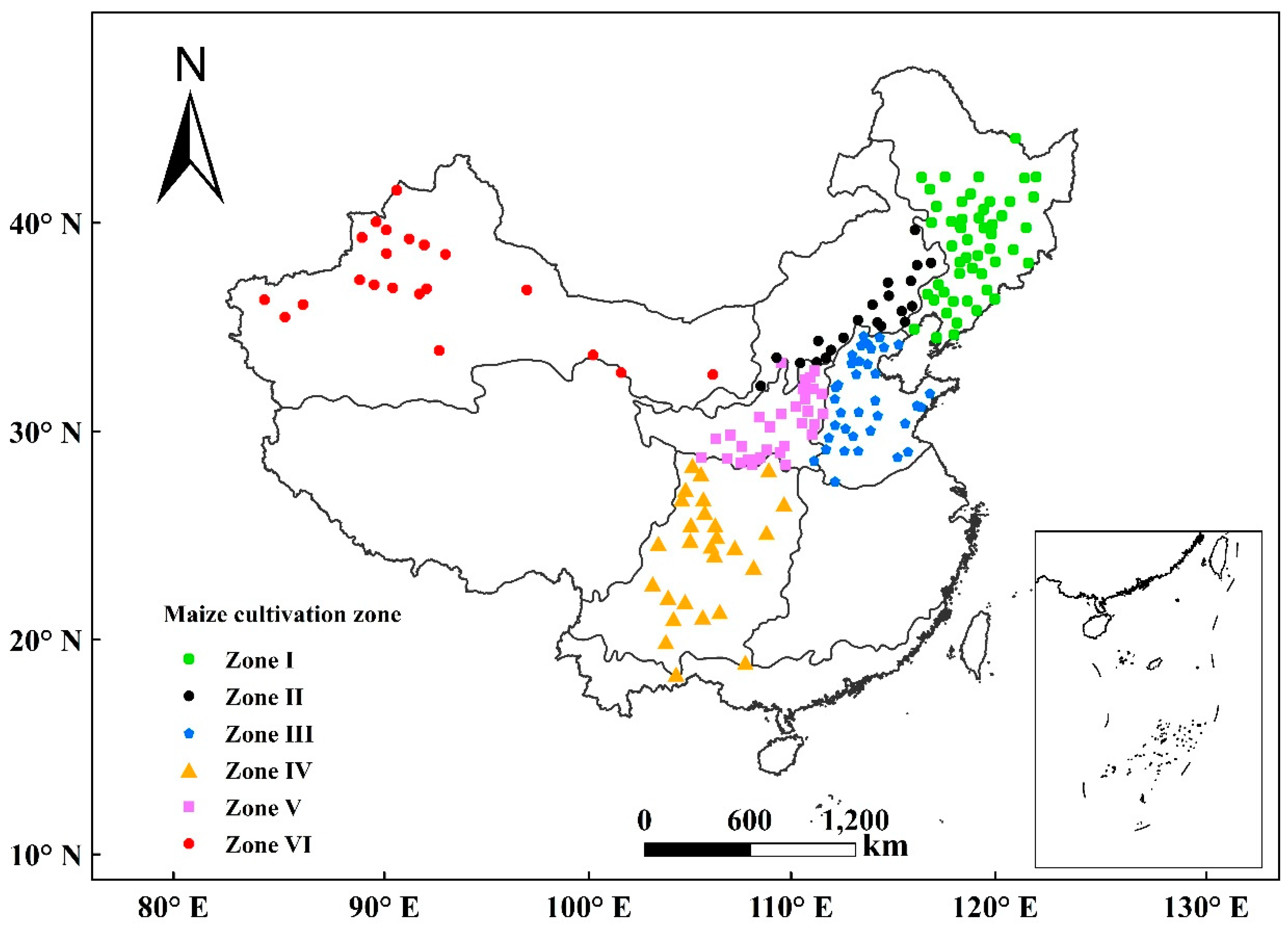
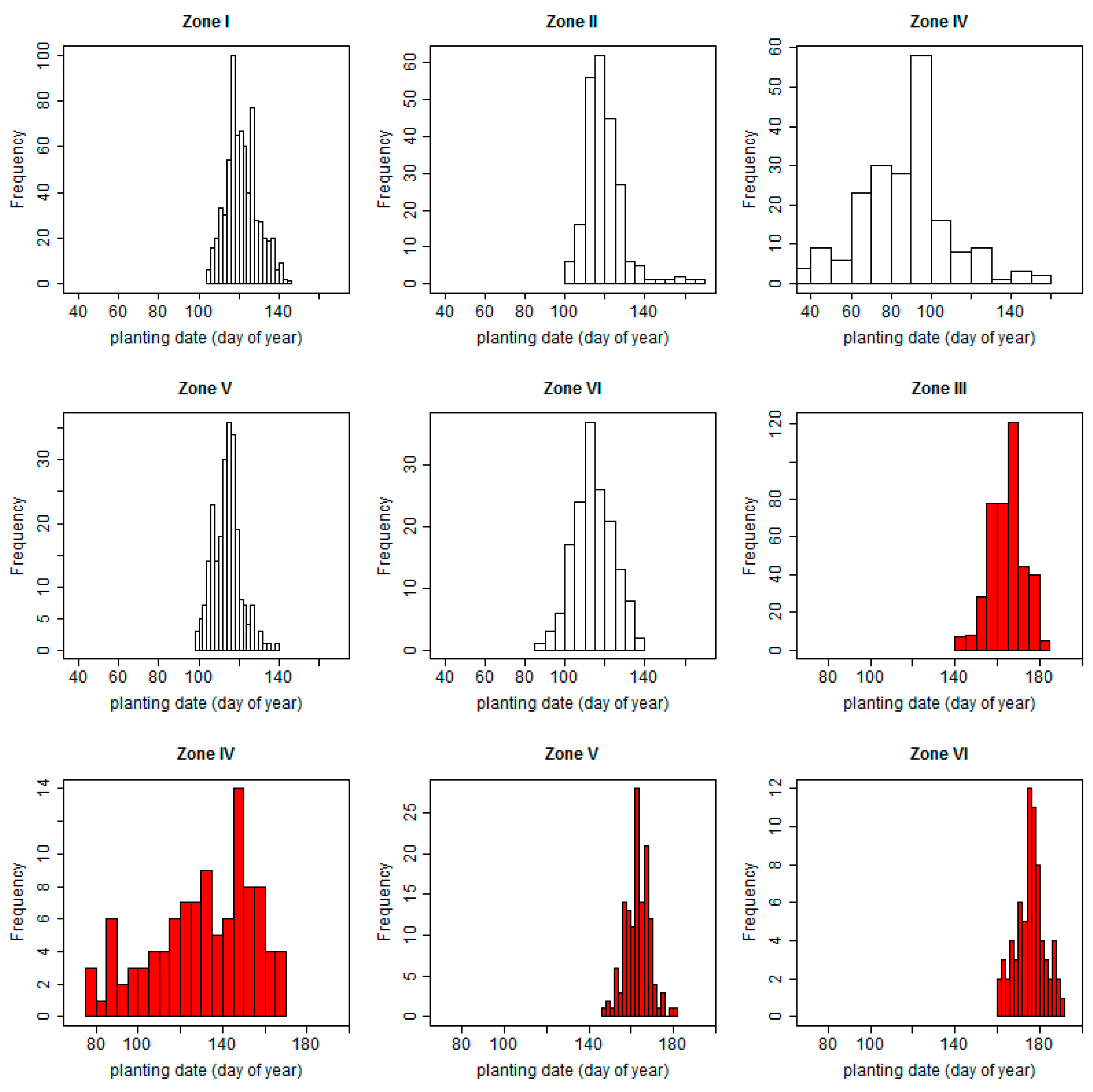
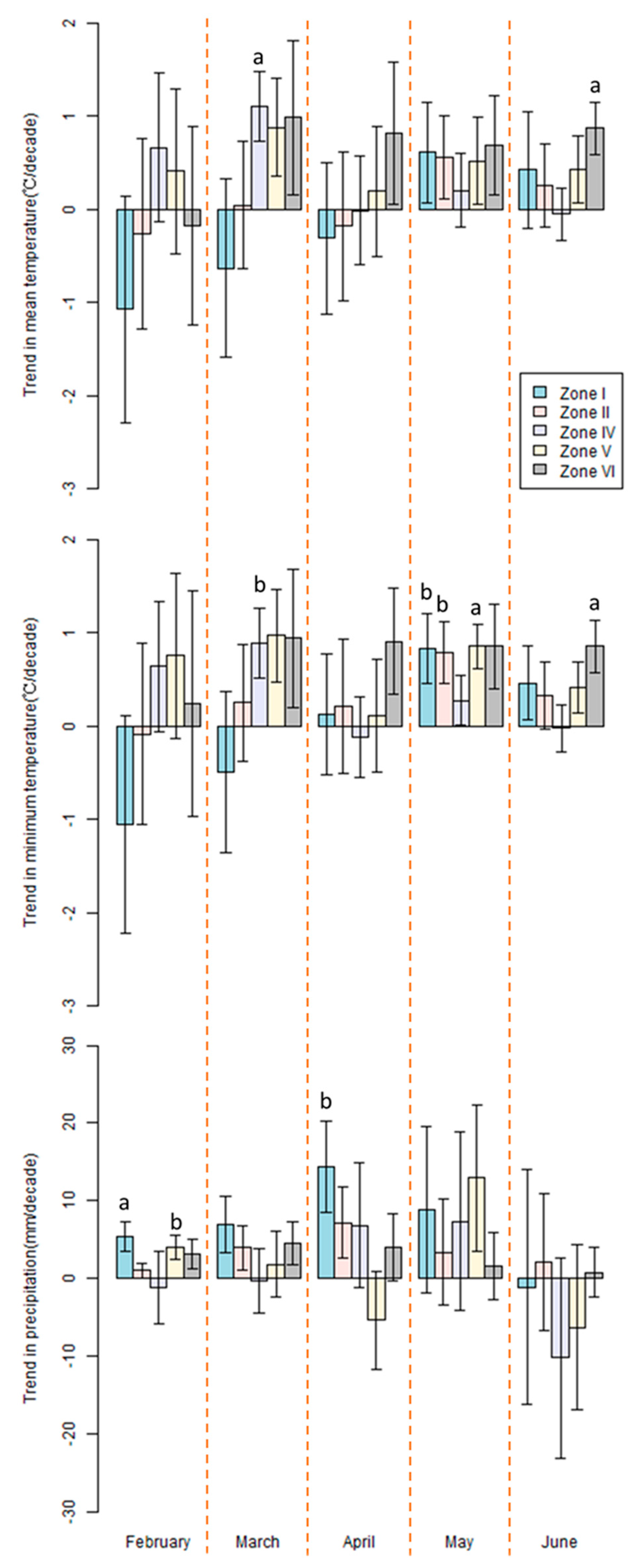
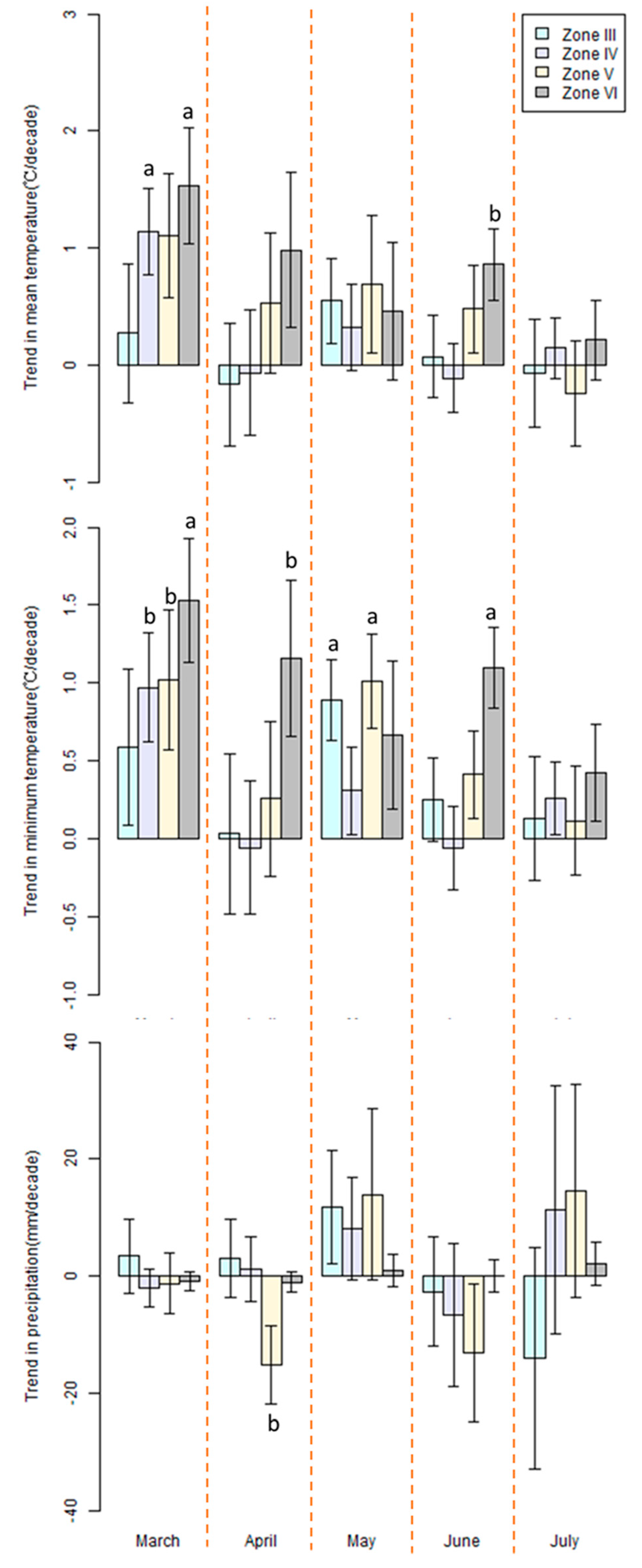
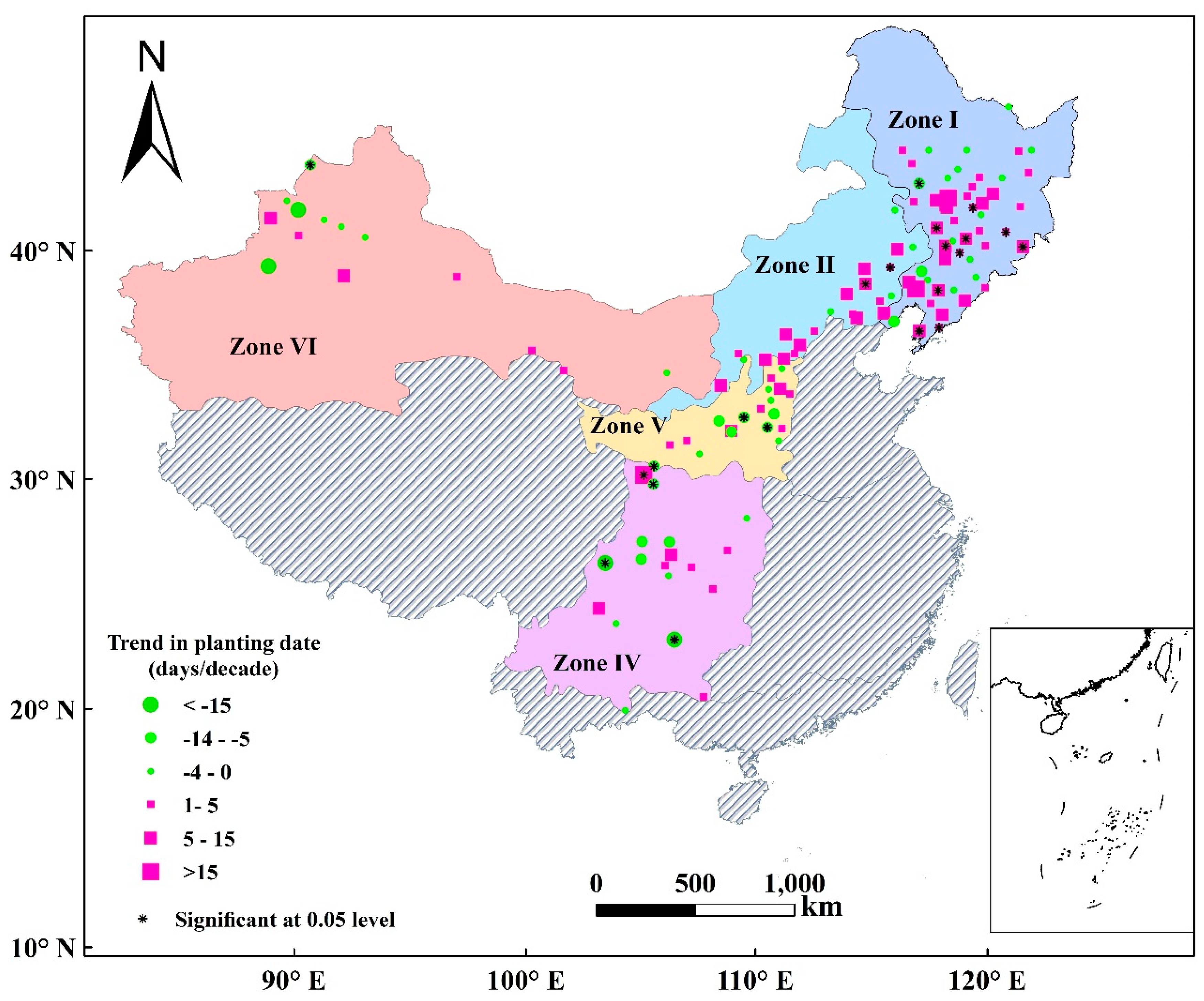
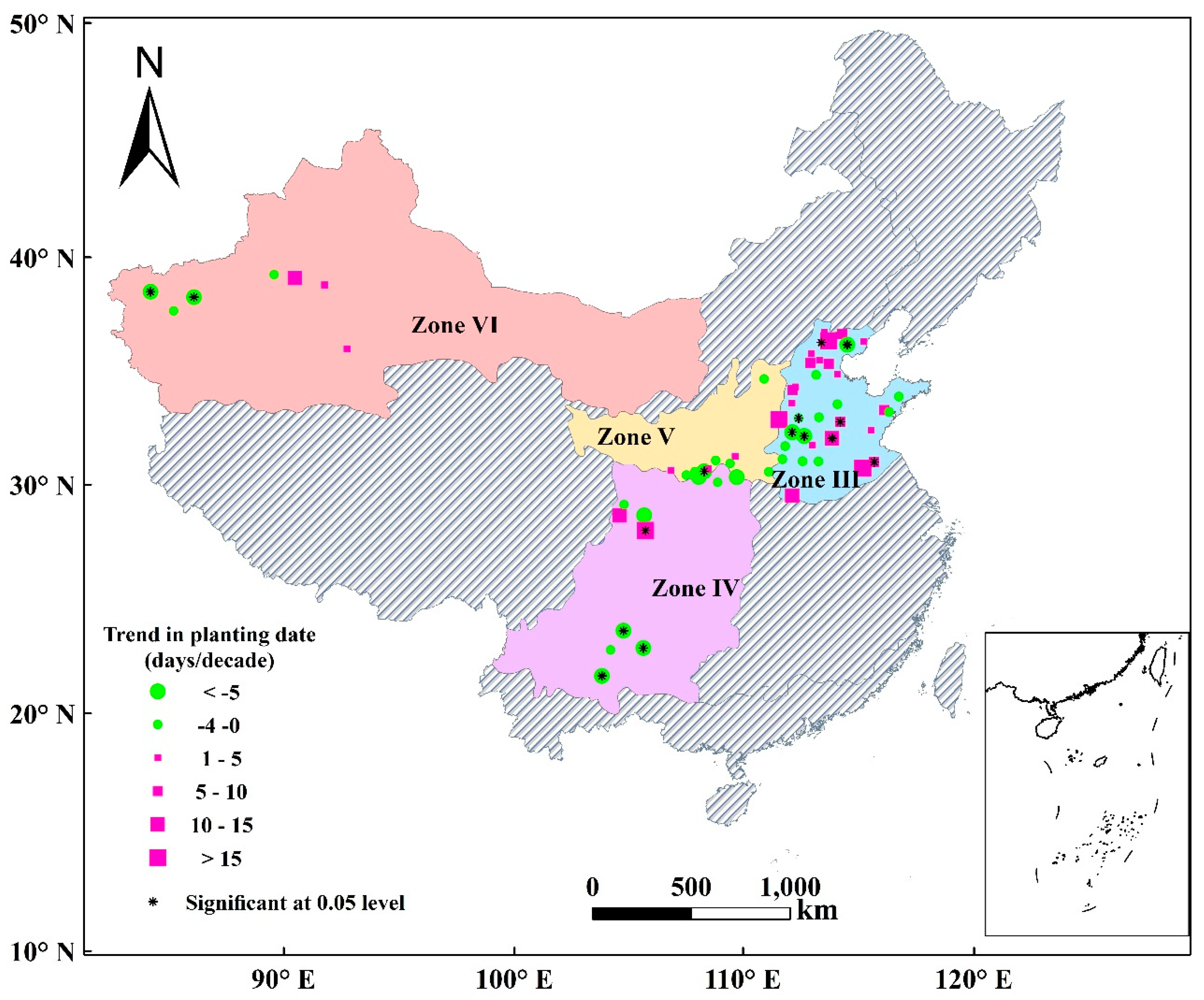
| Zones | Maize Type | Number of Stations | Number of Samplings | Mean Planting Day (day of year) | Mean Annual Temperature (°C) | Mean Annual Precipitation (mm) |
|---|---|---|---|---|---|---|
| I | Spring maize | 51 | 700 | 122 | 6.0 | 570.3 |
| II | Spring maize | 21 | 230 | 119 | 7.9 | 412.1 |
| III | Summer maize | 36 | 409 | 165 | 13.3 | 622.9 |
| IV | Spring maize | 18 | 197 | 88 | 15.5 | 995.8 |
| Summer maize | 9 | 104 | 130 | |||
| V | Spring maize | 20 | 235 | 114 | 11.0 | 524.8 |
| Summer maize | 12 | 136 | 163 | |||
| VI | Spring maize | 14 | 158 | 114 | 9.4 | 163.6 |
| Summer maize | 7 | 72 | 176 |
| Variables | Abbreviations | PC1 | PC2 | PC3 | PC4 |
|---|---|---|---|---|---|
| monthly mean temperature of February | T2 | 0.85 | −0.18 | 0.18 | −0.14 |
| monthly average minimum temperature of February | Tmin2 | 0.85 | −0.15 | 0.17 | −0.11 |
| monthly precipitation of February | P2 | 0.06 | 0.01 | 0.68 | 0.45 |
| monthly mean temperature of March | T3 | 0.88 | −0.24 | 0.02 | −0.22 |
| monthly average minimum temperature of March | Tmin3 | 0.9 | −0.19 | 0.07 | −0.22 |
| monthly precipitation of March | P3 | 0.05 | 0.19 | 0.65 | −0.1 |
| monthly mean temperature of April | T4 | 0.83 | −0.14 | −0.15 | −0.2 |
| monthly average minimum temperature of April | Tmin4 | 0.9 | −0.1 | −0.03 | −0.1 |
| monthly precipitation of April | P4 | 0.12 | −0.28 | 0.57 | 0.43 |
| monthly mean temperature of May | T5 | 0.7 | 0.09 | −0.29 | 0.54 |
| monthly average minimum temperature of May | Tmin5 | 0.81 | 0.27 | −0.12 | 0.41 |
| monthly precipitation of May | P5 | 0.00 | 0.28 | 0.64 | −0.32 |
| monthly mean temperature of June | T6 | 0.29 | 0.91 | −0.05 | 0 |
| monthly average minimum temperature of June | Tmin6 | 0.53 | 0.73 | −0.08 | 0.13 |
| monthly precipitation of June | P6 | 0.04 | −0.66 | −0.1 | 0.3 |
| Eigenvalues | 6.05 | 2.25 | 1.83 | 1.25 | |
| % of Variance | 40 | 15 | 12 | 8 | |
| Cumulative % | 40 | 55 | 68 | 76 |
| Variables | Abbreviations | PC1 | PC2 | PC3 |
|---|---|---|---|---|
| monthly mean temperature of March | T3 | 0.78 | 0.35 | 0.02 |
| monthly average minimum temperature of March | Tmin3 | 0.74 | 0.45 | −0.11 |
| monthly precipitation of March | P3 | 0.08 | 0.51 | −0.38 |
| monthly mean temperature of April | T4 | 0.79 | 0.18 | 0.14 |
| monthly average minimum temperature of April | Tmin4 | 0.79 | 0.38 | 0.06 |
| monthly precipitation of April | P4 | 0 | 0.61 | −0.07 |
| monthly mean temperature of May | T5 | 0.81 | −0.21 | 0.25 |
| monthly average minimum temperature of May | Tmin5 | 0.84 | 0.02 | 0.12 |
| monthly precipitation of May | P5 | 0.04 | 0.52 | −0.63 |
| monthly mean temperature of June | T6 | 0.86 | −0.27 | 0.02 |
| monthly average minimum temperature of June | Tmin6 | 0.9 | −0.13 | 0.06 |
| monthly precipitation of June | P6 | −0.12 | 0.38 | 0.58 |
| monthly mean temperature of July | T7 | 0.75 | −0.45 | −0.22 |
| monthly average minimum temperature of July | Tmin7 | 0.77 | −0.26 | −0.21 |
| monthly precipitation of July | P7 | −0.04 | 0.56 | 0.46 |
| Eigenvalues | 6.48 | 2.26 | 1.31 | |
| % of Variance | 43 | 15 | 9 | |
| Cumulative % | 43 | 58 | 67 |
| Zone | OLS Regression | R2 |
|---|---|---|
| I | PD = 122.13 − 4.24PC1 + 0.52PC2 + 0.69PC3 + 1.09PC4 | 0.32 |
| II | PD = 119.55 + 0.36PC1 − 2.24PC2 − 0.65PC3 | 0.05 |
| IV | PD = 87.70 − 12.51PC1 − 2.47PC2 | 0.33 |
| V | PD = 114.43 + 0.50PC1 − 1.30PC2 − 0.38PC3 | 0.03 |
| VI | PD = 114.56 − 0.37PC1+ 3.09PC2 + 1.19PC3 | 0.10 |
| Zone | OLS Regression | R2 |
|---|---|---|
| III | PD = 165.17 − 3.90 PC1 − 2.21PC2 − 0.15PC3 | 0.31 |
| IV | PD = 130.62 + 15.08PC1 − 10.01PC2 + 5.38PC3 | 0.59 |
| V | PD = 163.52 − 1.81PC1 + 0.27PC2 | 0.09 |
| VI | PD = 176.11 + 0.47PC1 − 2.89PC2 + 3.04PC3 + 0.56PC4 + 0.70PC5 | 0.33 |
© 2019 by the authors. Licensee MDPI, Basel, Switzerland. This article is an open access article distributed under the terms and conditions of the Creative Commons Attribution (CC BY) license (http://creativecommons.org/licenses/by/4.0/).
Share and Cite
Sheng, M.; Zhu, A.-X.; Rossiter, D.G.; Liu, J. How Much Are Planting Dates for Maize Affected by the Climate Trend? Lessons for Scenario Analysis Using Land Surface Models. Agronomy 2019, 9, 316. https://doi.org/10.3390/agronomy9060316
Sheng M, Zhu A-X, Rossiter DG, Liu J. How Much Are Planting Dates for Maize Affected by the Climate Trend? Lessons for Scenario Analysis Using Land Surface Models. Agronomy. 2019; 9(6):316. https://doi.org/10.3390/agronomy9060316
Chicago/Turabian StyleSheng, Meiling, A-Xing Zhu, David G. Rossiter, and Junzhi Liu. 2019. "How Much Are Planting Dates for Maize Affected by the Climate Trend? Lessons for Scenario Analysis Using Land Surface Models" Agronomy 9, no. 6: 316. https://doi.org/10.3390/agronomy9060316
APA StyleSheng, M., Zhu, A.-X., Rossiter, D. G., & Liu, J. (2019). How Much Are Planting Dates for Maize Affected by the Climate Trend? Lessons for Scenario Analysis Using Land Surface Models. Agronomy, 9(6), 316. https://doi.org/10.3390/agronomy9060316





